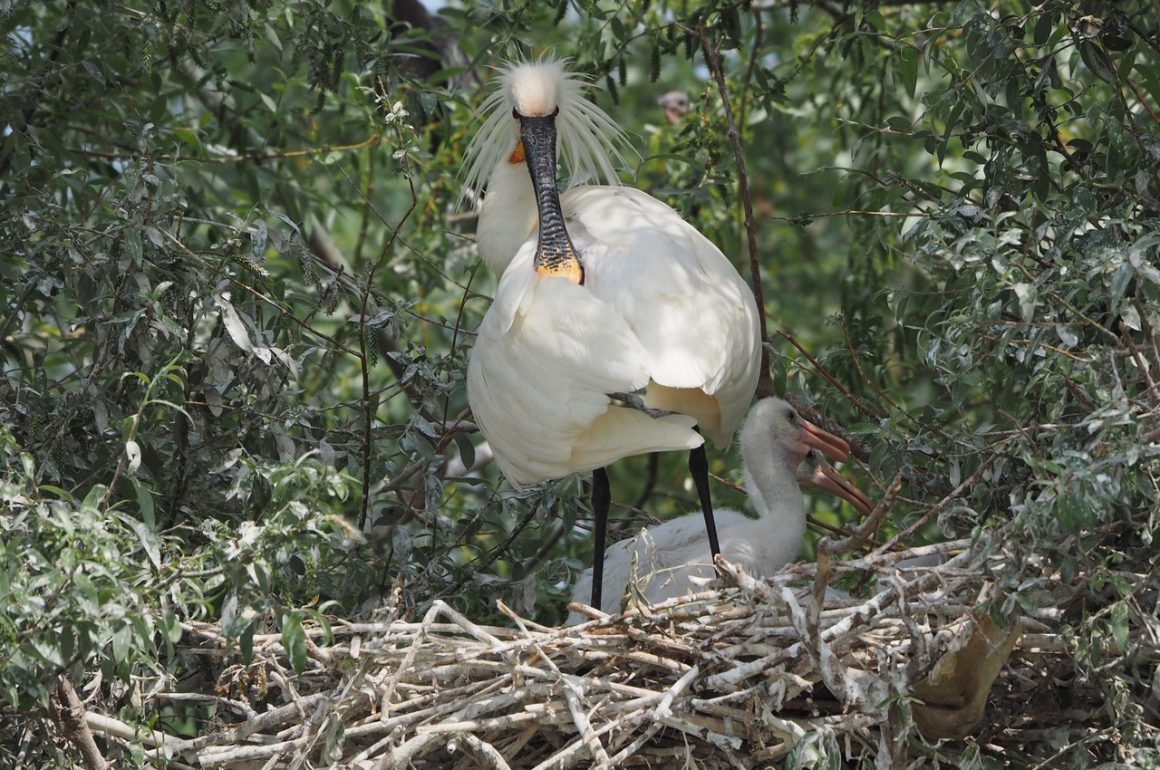
Though the birding around Lake Kerkini may be outstanding, it’s inevitably the lake itself that is the centre of interest. It’s a reservoir, not a natural lake, and was formed by damming the Striminos river, which flows into Greece from neighboring Bulgaria (unfortunately bringing with it huge amounts of plastic rubbish, creating problems for the National Park.) The first dam was built in 1932, but the most recent work, building up the embankments, took place in 1982.
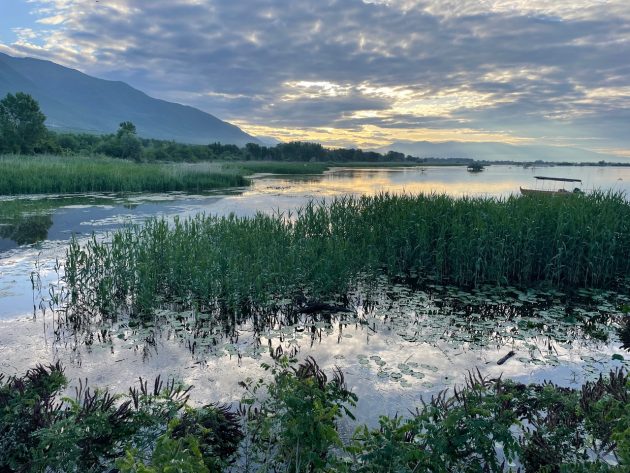
Kerkini at dawn. This photograph was taken at Mandraki, at the northern end of the lake, in early May, when water levels are high
The lake reaches its peak height in late May and early June, depending on the snow melt, but even then the level will fluctuate widely depending on the flow of the Striminos. During the summer the lake water is used for irrigation on farmland below the dam. At its peak in the early summer, the lake covers 72 square kilometres, reducing to 54sqkm in the autumn and winter, when extensive mud flats are exposed, attracting big flocks of Greater Flamingoes, wildfowl and waders.
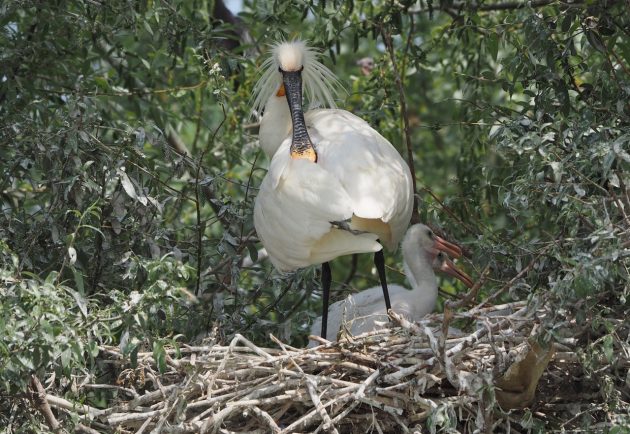
This photograph of a Spoonbill at its nest in the flooded forest was taken nine years ago. Few suitable nesting trees still survive today
When I visited Kerkini last month, the water was high as high as I have ever seen it, though the number of ducks and geese was low, as is usual. There were a few Mallard, and the odd Ferruginous Duck, along with Greylag Geese and Mute Swans. The Greylags are interesting, as they are of the eastern race, rubrirostris, with distinctive pink legs and beaks, unlike the orange of our birds at home in Britain.
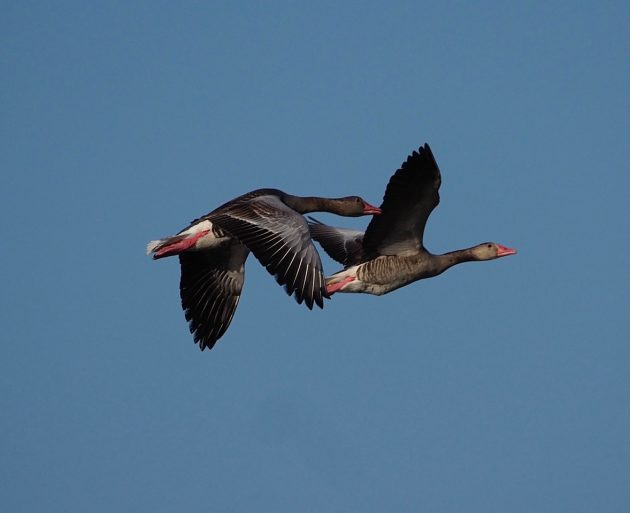
Eastern Greylag Geese have pink bills and legs
There may not be many ducks, but there are huge numbers of other birds that swim. Kerkini is shallow and is enormously productive, producing enough fish to feed a summer population of many thousands of Great Cormorants, along with hundreds of Great White and Dalmatian Pelicans, plus numerous other fish-eating birds. The pelicans are the real stars of the lake, with the Dalmatian Pelicans attracting bird photographers from all over Europe. The top month for photography is in February, when the pelicans’ beak pouches are a wonderfully rich shade of orange. This indicates peak breeding condition, but by May their pouches are back to pale yellow again. Both species of pelicans breed on the lake, with the Dalmatians the more numerous. Intriguingly, the latter have been badly affected by bird flu, an illness that didn’t affect the Great Whites.
For western birdwatchers, Pygmy Cormorants are a major attraction, for these diminutive cormorants are a Balkan special, and Kerkini is one of the best places to see them. Though greatly outnumbered by their larger cousins, they are easy to see, and equally easy to recognise due to their small size.
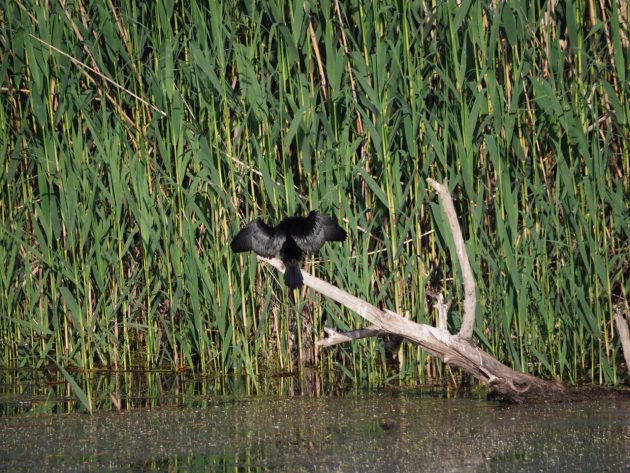
Pygmy cormorant, a Balkan special
Such an abundance of fish attracts herons, and at Kerkini you can see the full complement of European breeding species: Grey Heron, Purple Heron, Night Heron, Squacco Heron, Little Egret and Great White Egrets all breed. The latter is a relatively new colonist, and has recently been joined by Cattle Egret, though the latter remains scarce.
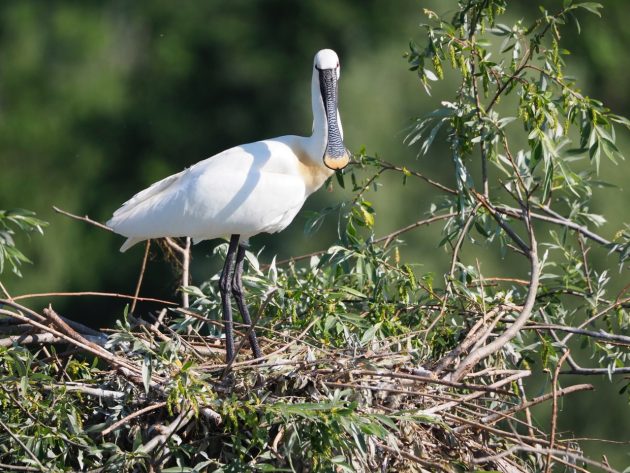
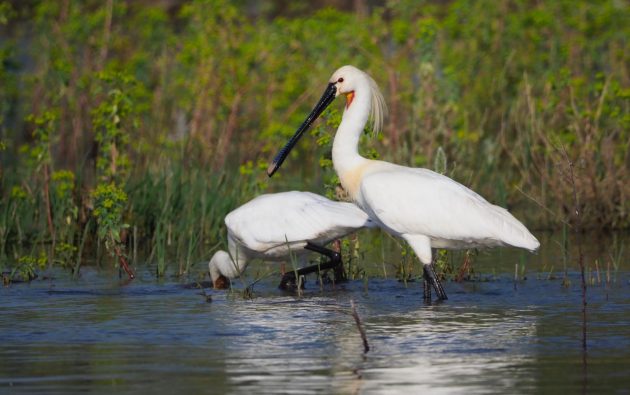
Spoonbills: birds are now breeding away from the lake due to loss of suitable nest sites
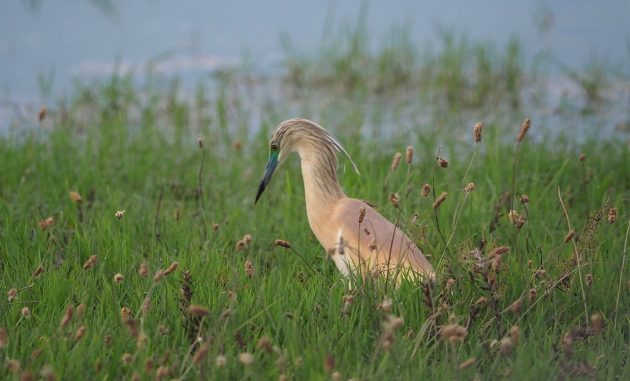
Squacco Herons are common breeding birds
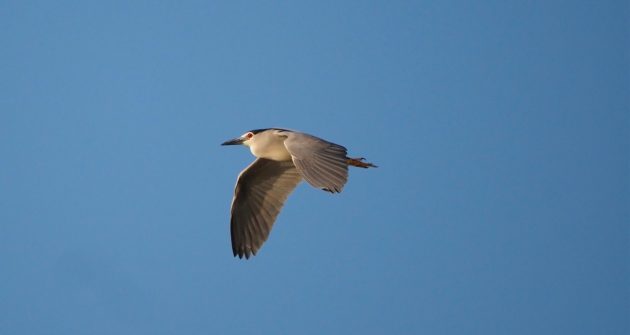
Not just active at night: a Night Heron
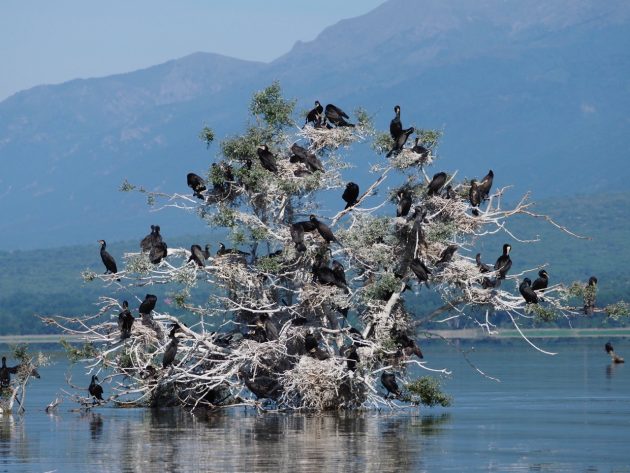
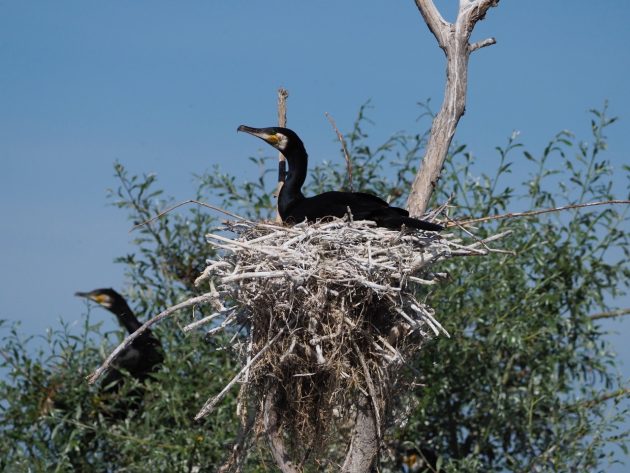
Cormorants now struggle to find nest sites. The tree festooned with nests (top) is unlikely to last more than another season
Sadly, in the 16 years that I have been visiting Kerkini, I’ve seen a drastic reduction in the size of the old drowned forest which until recently supported huge numbers of nesting cormorants, herons, egrets and Spoonbills. The trees cannot cope with the huge seasonal changes in the water level, and there is no regeneration, either, so what was until recently a thriving bird city is now in terminal decline. Many of the herons and egrets, along with the Spoonbills, have already abandoned the drowned forest, and now nest in woods within commuting distance of the lake.
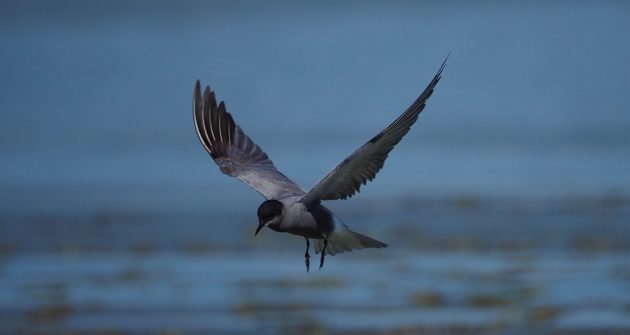
Black Tern: a common passage migrant in spring, but now a scarce breeding bird
The fluctuations in the water level are not good for the water lilies, so the huge beds of lilies that once existed have declined, so the lake is no longer as attractive as it once was for nesting marsh terns. Take a boat trip on Kerkini in May and you should see Black and possibly Whiskered Terns, but few now breed. The huge population of Great Crested Grebes also struggles to nest successfully due to the fluctuating water levels, while this year, for the first time, I failed to see any Black-necked Grebes, once a regular breeding bird.
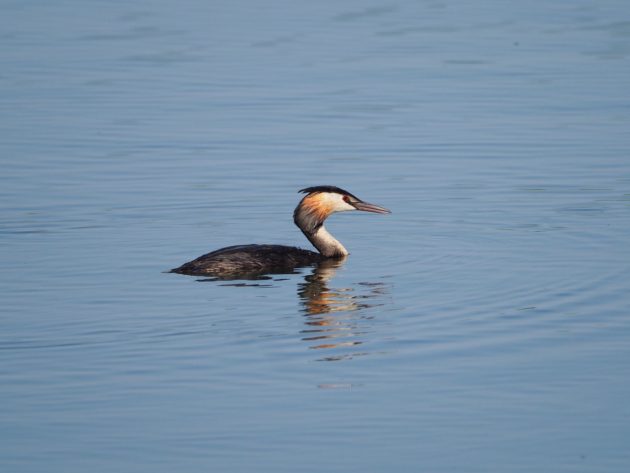
Fluctuating water levels adversely affect the nesting success of the large population of Great Crested Grebes that attempts to breed on the lake
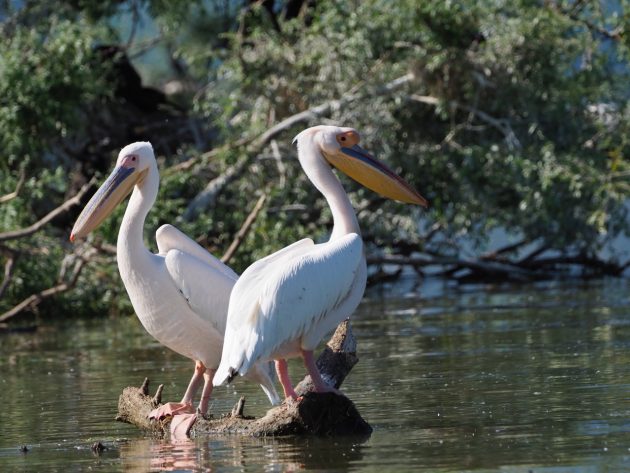
White Pelicans now breed at Kerkini in small but growing numbers. The flock (below) is commuting back to Lake Prespa after a fishing expedition at Kerkini
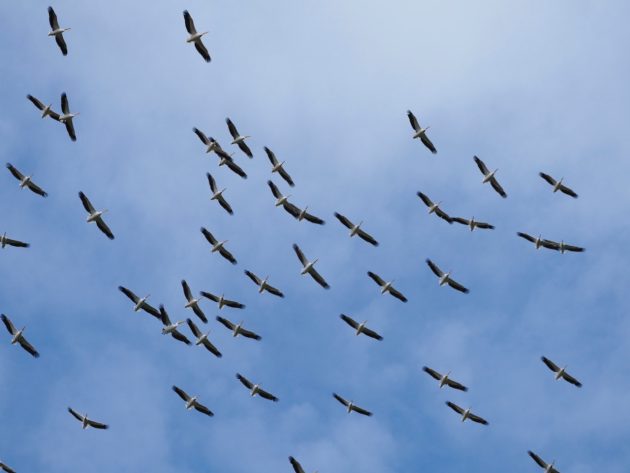
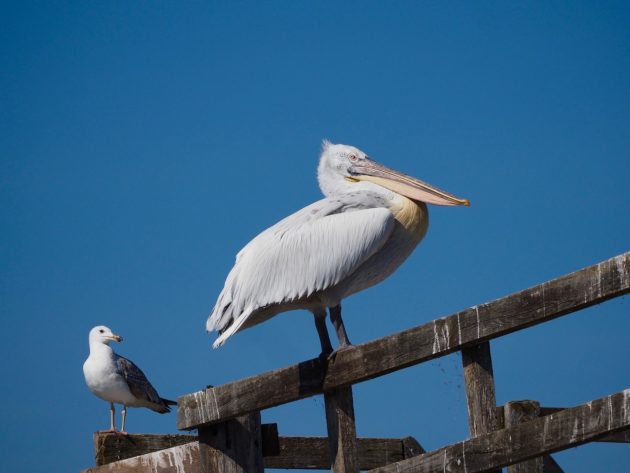
By May Dalmatian Pelicans no longer have the distinctive orange beak pouches that they develop in early spring, and which the photographers so enjoy
That’s the bad news, but the good news is that the lake remains astonishingly fertile, and is more than capable of supporting such huge numbers of fish-eating birds. Such is its productivity that White Pelicans, nesting on Lake Prespa over 150 kilometres away, will fly down to Kerkini to fish.
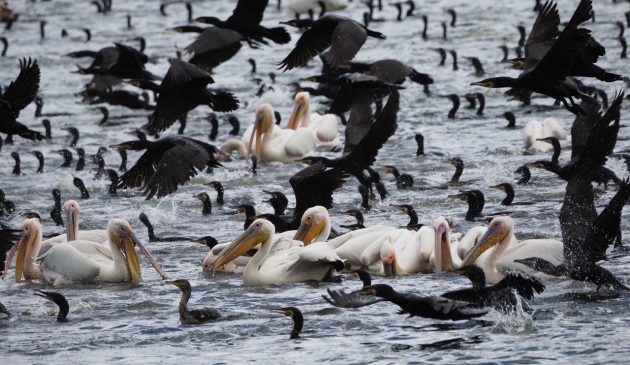
A mass feeding frenzy. Pelicans and Cormorants jostle together for the best fishing
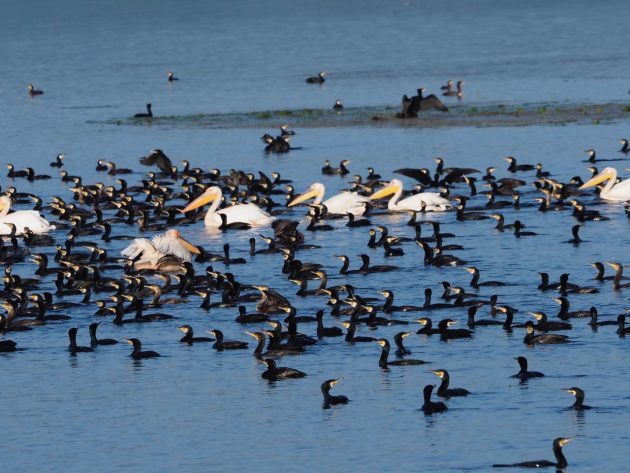
The feeding frenzy is over. The birds are now starting to disperse
A mass fishing is a sight not to be missed. It generally starts when the Cormorants find shoals of fish close to the surface. Thousands more are quickly attracted, flying low in long, waving black lines across the lake. They pack on to the water, diving continually. Here they are invariably joined by both Dalmatian and White Pelicans, while if the mass fishing takes place near the shore, it will attract crowds of herons and egrets, too. It is a spectacular sight and sound as thousands of birds indulge in a mass feeding frenzy. Then, quite suddenly, the fishing stops (have the fish shoals dived to deeper water?), and the great crowds of birds disperse. These mass fishings take place daily, but the lake is large, so one needs a little luck to observe such a spectacle.
Anyone interested in visiting Kerkini should buy a copy of Birdwatching in Northern Greece, by Steve Mills, and available from www.birdwing.eu. Now in its third edition, it’s a beautifully illustrated and comprehensive guide to the birds of Northern Greece, and where to find them. It gives comprehensive coverage of Lake Kerkini.











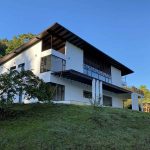
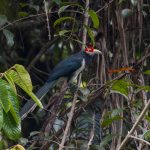
A circular dyke to zone of an area of constant level might be a solution. Always the Dutchman, of course, but the level of interference necessary (?) in the Netherlands to keep conditions right is astonishing. One simple solution for you Black Terns: little rafts. We should start a crowdfunding campaign for this in the advertisement section of this website…
“The trees cannot cope with the huge seasonal changes in the water level, and there is no regeneration, either, so what was until recently a thriving bird city is now in terminal decline.”
For long it was assumed that the saplings cannot survive being under water half a year, from spring to August, but recently another theory was tested. Asian water buffaloes both graze grass and browse younger branches and saplings. Hence, the experiment was created: a plot was fenced off to keep the animals away and now willow saplings did survive being submerged for half a year. Three years later, when young trees were too thick for hungry bovines, the fence was moved to the next plot. While this sounds like victory, the situation is more complicated. More in my blog, here: https://www.10000birds.com/saving-the-drowning-cormorant-or-the-kerkini-lake-greece.htm
“…the Dalmatians the more numerous. Intriguingly, the latter have been badly affected by bird flu, an illness that didn’t affect the Great Whites.”
It’s the later start of the breeding season for the Great Whites that saved them. One tenth of the global population of Dalmatian Pelican breed at Prespa Lakes NP and can be observed from March to early October. Yet, in 2022, the bird flu killed more than 60% of the breeding pelicans at Lesser Prespa Lake, causing the greatest ecological disaster on record for Greek wildlife. The Dalmatians start with nesting as soon as their mountain lake is ice free in March, but the Great Whites arrive later, in April-May, and due to warmer days and lower activity of the virus, were mostly spared.
Many thanks, Peter and Dragan, for your comments. I was intrigued as to why the Dalmatian Pelicans have suffered from bird flu, but not the Great Whites: Dragan’s facts supply the answer.
I’m sure that the lake’s levels could be better regulated, but I don’t think that it’s a high priority.